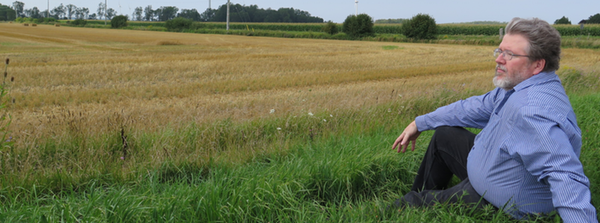In the Image of the Beloveds
“Even in these early pastorals, ghosts threaten quietude. Storm clouds loom; wind tosses trees; a farmer looks anxiously at the sky; a horse and cart are rendered by trick of perspective tiny and vulnerable under a brooding penumbra of woods and dusk. It is as if there is a knowing nod here to a reckoning; that this fragile peace, this imagined past redeemed by longing, this beloved new-old arcadia, yearly greening, will in its turn fail, and will fall into some new axis of monetary necessity or opportunity: debt or investment; cash or credit.”—William Ramp
Small Things Recollected
By Dr. William Ramp
“Ideas are to objects as constellations are to stars.”—Walter Benjamin, translated from Trauerspiel, 1928.
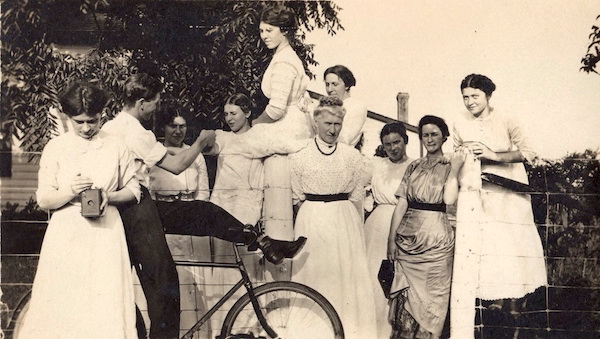
LETHBRIDGE, ALBERTA Canada—(Weekly Hubris)—April 2019—This is the third in a series of reflections on the meanings granted by encounters with old photographs. Some of my meditations are anchored in inscriptions or labels, or in shared memory. Some respond instead to an apparent lack of information; to orphaned, ambiguous, or ghostly images. In my last column, I said I would present the present batch with minimal commentary, allowing you to form and consider your own impressions. Instead, I confess to having chosen images to fit the general theme of this issue of Weekly Hubris, the greening (again) of love. Having thematized them, I couldn’t resist the urge to comment on some, impressionistically and at length. Read and appreciate the commentary for what it is and however far it takes you. Beyond that, please do feel free to read these images against the grain of the words given with them. Read them in light of your own responsive impressions, and then perhaps also against your own grain. See what you come up with.
For a sense of the thinking and approach I bring to them, not always consistently, see here, and also here.
This April’s melting snow returns life to a northern hemisphere not yet ruined by climate change, though as I write, large swathes of the US Midwest have been devastated by floods of historic proportions. The warming that brings life brings both promise and pain, as Eliot noted already a century ago—
April is the cruellest month, breeding
Lilacs out of the dead land, mixing
Memory and desire, stirring
Dull roots with spring rain.
Winter kept us warm, covering
Earth in forgetful snow, feeding
A little life with dried tubers.
The soil warms for another year’s germination. Let the seedbed of reflection do the same.
![]()
Present In Absentia: Beloved Landscapes
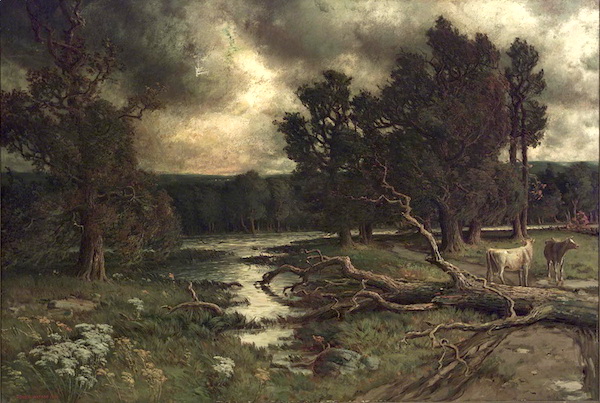
This is the kind of landscape that set elderly farmers and their newly-urbanized and nostalgic children to dream and reminisce a hundred and thirty years ago. An elegiac landscape of the sort painted by hundreds of 19th-century artists great and small; members of the Hudson River School, imitators of the Barbizon School, and thousands of amateurs unschooled. The signature landscape of North American admirers of Constable.
It is also the type of landscape that accompanied the end of a conquest, or what seemed like it. The land had been taken and surveyed and lotted and logged and stumped. Its raw wounds had long since grassed over; its remaining trees huddled in woodlots or served as boundary sentinels lining pasture where cattle safely grazed. These were images that celebrated quietude. In them, sweat and worry, privation and failure; the bite and blood of a mis-swung axe or crush of a crank-felled tree; the cough of consumption in close cabins; the dead children and spouses buried under trees like these, could fade into a dream of Arcadia as if Arcadia had not exacted its cost; had always been present to the wonderment of drovers, shepherds and harvesters.
These paintings are of a quite different genre from the contemporaneous line-drawn images found in lithographs and county atlases produced and sold by subscription across southern Ontario in the 1870s and 1880s. In the latter, the houses and barns of prominent farmers testify to the work of stone-boats and saws and pike poles; to busyness and building. Horses and democrats clip-clap smartly along straight roads and orderly fence-lines that advertise the reign of Accomplishment in all its commercial pride. In a way, these idealizations of Enterprise were more honest than the bucolic quietude of pastoral scenes in oils. Such vistas were only available to artists because of hard labor by hard men driven by imperial designs, survival necessity and economic desire. The pastoral idyll forgets fondly, places “under erasure” all the work of displacement, destruction and transformation: seizing, blazing, measurement, boundary-making, felling, stumping, burning. Of the first generation of European axe-wielders in this particular countryside, one observer wrote: “They have no life, no animation, no desire, no consideration save in and for the possession of ‘Hard Cash.’ Care, caution and calculation sit ever upon their brow, and they have not the least soul, save for ‘Improvements,’ ‘Water Privileges’ for saw and flour mills and any other method or contrivance for accumulating wealth.”
But in Watson’s early pastorals, as in so many the type, the conceit of the painter is that the resultant agricultural vistas aren’t accomplishments of settlement; they simply are. This sort of cover-up, if we can call it that, dresses old wounds, physical and psychic, that settlers inflicted on themselves and on the land in the process of “taming” a wilderness. Commerce, work and worry give way to a neverland of peaceful ground in which stern and parsimonious forebears and their dead children and spouses are alike entombed with crippled axe and scythe-wielders, hearth-burned or drowned infants, stooped ploughmen and tile-diggers. All fades into an eternity of green and grain. Et In Arcadia Ego.
Watson’s landscapes thus were likely intended more for appreciation by the children of the pioneers; successors to the successful, already in the market for nostalgia. These were their beloved vistas; idealized kingdoms of cattle, trees, and streams that answered a longing for home and hearth and homestead; that glossed over and soothed and smoothed rough childhoods and the betrayals of leave-taking and loss. But under Watson’s brush, this was a nostalgia haunted by past and possible future portents. He was better than most at this genre and if he began as a child of classical Romanticism, he moved on to Impressionism and ended a Modernist. Even in these early pastorals, ghosts threaten quietude. Storm clouds loom; wind tosses trees; a farmer looks anxiously at the sky; a horse and cart are rendered by trick of perspective tiny and vulnerable under a brooding penumbra of woods and dusk. It is as if there is a knowing nod here to a reckoning; that this fragile peace, this imagined past redeemed by longing, this beloved new-old arcadia, yearly greening, will in its turn fail, and will fall into some new axis of monetary necessity or opportunity: debt or investment; cash or credit.
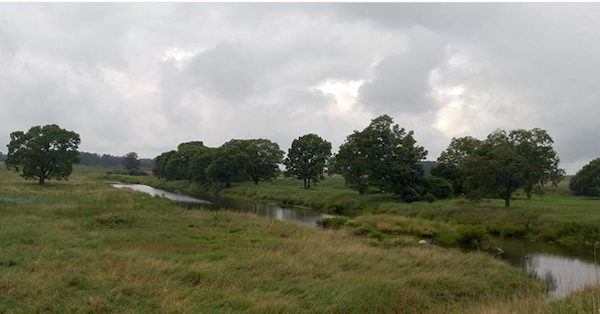
Behind me, as I took this photo: a highway bridge, an intersection, and a sign on the flood-plain announcing commercial land for sale, for fast-food outlets.
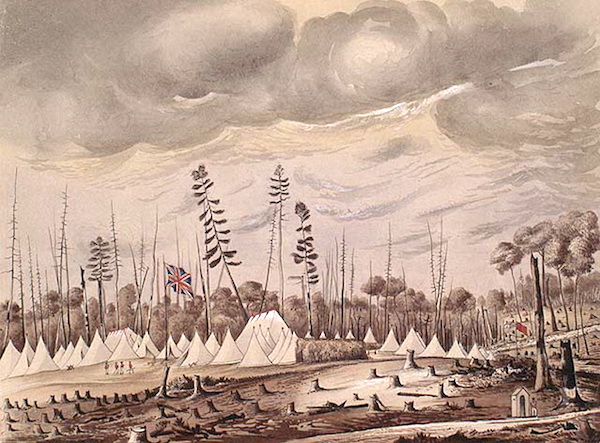
There is a contrast between the romantic pastoralism of Watson’s agricultural landscapes and some rural photographs taken in the same era. In the latter, it becomes evident that settlers and loggers did not cut every single tree in their way. Some were left standing, naked and spindly, without companion. Most farms retained woodlots, though the biggest trees in these were usually logged out later. But a few ancient giants with a wow in their length or ill-situated knots were left alone: in silviculture as in the moral culture of the time, straightness of stature signaled productive potential. Others lingered on the slopes of ridges or ravines that made felling too risky. Still others, towering twice as high as the surrounding bush, marked a failed field clearance. And some few, perhaps, were left out of whimsical respect. Lightning-blasted and surrounded by a clutter of lost limbs, these punctuated pastureland well into the 20th century.
When Europeans first entered the primeval forest and oak plains of Southern Ontario, they often represented the former as places of danger and disorientation which trapped sleighs and carts in bogs or blocked their way with windfalls. Stands of timber grew so thickly in imagination as to form impenetrable walls. The above watercolor marks a turning-point at which those walls were breached and finally levelled, about 40 years and 40 miles from where Watson would later get out his sketchbook and paints. Note the rawness of the landscape depicted studiously by the regimental surveyor. The remnant conifers are giving way to new deciduous growth. One, still alive and apparently healthy, leans at a crazy angle. Most of the others still standing are dead, deliberately girdled at the base and left to blow over on their own.
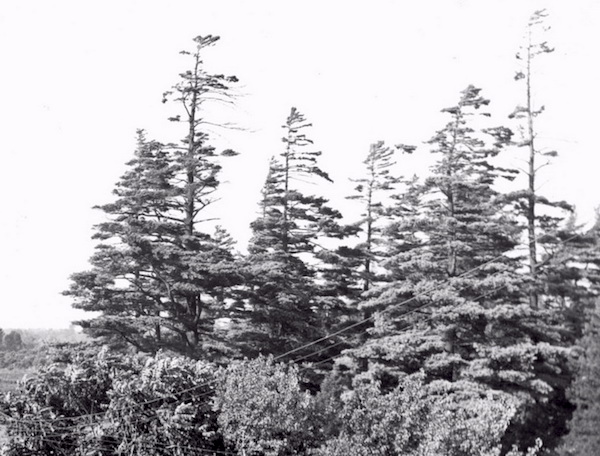
One of my ancestors thought here to record a remnant stand of 100- to 150-foot eastern white pines along the eastern edge of our farm; the last of a population of giants that once covered much of Ontario. Some are estimated to have reached 220 feet. Old photographs show 65-foot clear, straight logs with enormous boles bob-sledded down the streets of small towns to sawmills or the piers of lake and river ports. (At a farm auction near my home town, I once bought an old harvest table, roughly and locally-made, its leg-ends rotting, simply because it had for a top a single inch-thick pine board measuring a full three feet by six. In consternation at my foolishness, my family nicknamed it the “stinky table.”)
The Old Ones caught in this snapshot managed to escape the 19th-century logging craze that made board-foot calculations out of their peers simply by virtue of growing on a low sand ridge. It made little sense to the first settlers to expend energy and court danger by cutting them down solely to add a few acres of unproductive blow-sand to an “arable” box on a census. Perhaps some now-unknown early proprietor also resisted a logger’s blandishments. In any event, they persisted, to be transformed in memory from a stubborn enemy of clearance, or a calculation of relative worth, into a sylvan refuge we called “the grove.” They loom in the background of countless family photos. Note the very tallest: its extreme height and almost evanescent slimness indicates that once it was likely surrounded by others, impossibly taller still. Under their soughing canopy, my mother sat on a granite boulder throne and played princess, while Monarchs and Admirals, Painted Ladies and Hairstreaks, Great Spangled Fritillaries and Tiger Swallowtails paid her a fluttering court.
The photo dates from the 1930s; all these trees were still standing when I was young, and my grandfather swore they were the same size when he was a boy. But by the 1990s, long after we left, they had all been taken down for lumber—all except for the very tallest, which I like to think saw the end coming and died on its own in the early 1980s. Perhaps, as the neighbor who made the decision argued, their thinning future had already become untenable.
Later still, the knoll on which they stood was truncated by excavators intent on the sand in which they had rooted their biomes. Sand is now a scarce resource in a booming world market for construction materials, and thus is profitable to mine. We think of fossil fuel extraction these days as the Main Enemy, but it is the development and construction industries which have concreted much of the living planet, which have in country after country avidly cultivated ties to mafias, gangs, and mobs, which have beaten back labor unions and regulation, which see no vista, no ecosystem as sacred; which make no connection between any of this and a carbon crisis. Sand, like oil and, now, fresh water, is just another material for extractivism; a regime in which a skein of law-abiding business masks shadowy deals that undo laws and zoning and compliance with payoffs, and with threats.
We loved those trees. Did they love us back? Trees, it was once thought, were not sentient and were, like us, individuals. More recent botanical research indicates otherwise. Trees sense threat collectively; they co-operate with other organisms in rooted biological communities, they do not just compete for canopy space but give way to each other. Perhaps, while we loved them, they saw in our temporary adoration only the interim stanching of a still-open wound.
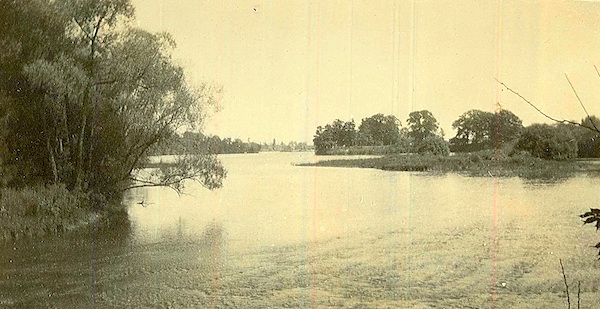
Stephen P. H. Butler Leacock, FRSC (1869–1944) studied under Veblen at Chicago, and for many years chaired the Department of Economics and Political Science at McGill University in Montreal. He was a staunch conservative and imperialist in his politics. But he was far better known between 1915 and 1925 as the most popular humorist in the English-speaking world and, if he is read at all today, it is for his Sunshine Sketches of a Little Town (1912); tales of rustic foibles in a small lakeside town he called Mariposa, a lightly-fictionalized version of Orillia, Ontario.
This photo is un-prepossessing, and I have cropped it rather heavily to straighten it. It was taken between 1910 and 1916 by a very Edwardian young woman, perhaps leaning from a timber bridge below a mill seat, or out for a row in a rental boat. Her Kodak Brownie lens is pointed toward Goosey Island, which sat in the middle of Silver Lake. The resultant image is an exercise in nature romanticism, of a piece with the first stirrings of a conservation movement in Canadian settler culture. And the young woman remained a nature-lover all her long life. But now, the kicker: Silver Lake was artificial. Its waters were held, in pent-up penstocked passion, by Penman’s Dam. It provided power for a mill that turned out knit undies and knickers and other naughties by the thousands of pairs. The mill featured a comfort station for its workers that emptied straight into the river below the dam, earning the wrath of a Provincial Waterways Inspector, who, one hopes, did not inspect it from directly below.
In short, this is a most Mariposian idyll.
![]()
Beloved Ones: The Human
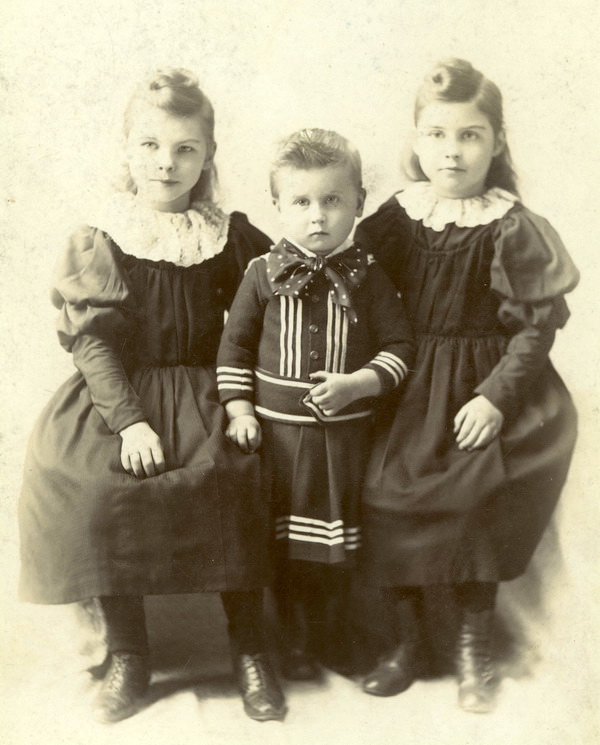
Two photographs, one above, one below, separated by six decades. Each portrays a boy who was father to the man. Both images, to me, are revealing. Both call out in me a response I do not have to later pictures of the same subjects.
The earlier photo is of my grandfather and his two elder sisters. In adulthood, he could be a hard man to be easy around. He could be by times shy and a performer larger-than-life; a man of definite and at times contradictory opinions, a keen observer, a willing and at times endless talker. He was also wound tight, often wildly-frustrated, a worrier, a pessimist, at times an arbitrary and difficult employer and parent. He suffered but made others suffer, too. Regardless, I spent a good deal of time with him and listened to him; we had a bond that my father (his son-in-law and employee) did not fully approve.
Here, he is knotted with a ridiculously-huge bow tie, and clad in overstated, starched togs in caricature of some future adult role (like the ubiquitous sailor suit). In the middle-class habitus of the day, the sorrowful little boy serves the iconography of the cute and the ghost of his future. But I look into his eyes and all of that falls away, except as a stage-prop contrast. Clearly, he has been bidden to stand still and follow instructions. He wants it all to be over. He does not really understand. He tries to do what is wanted of him, but he cannot yet mask the effort with a smile.
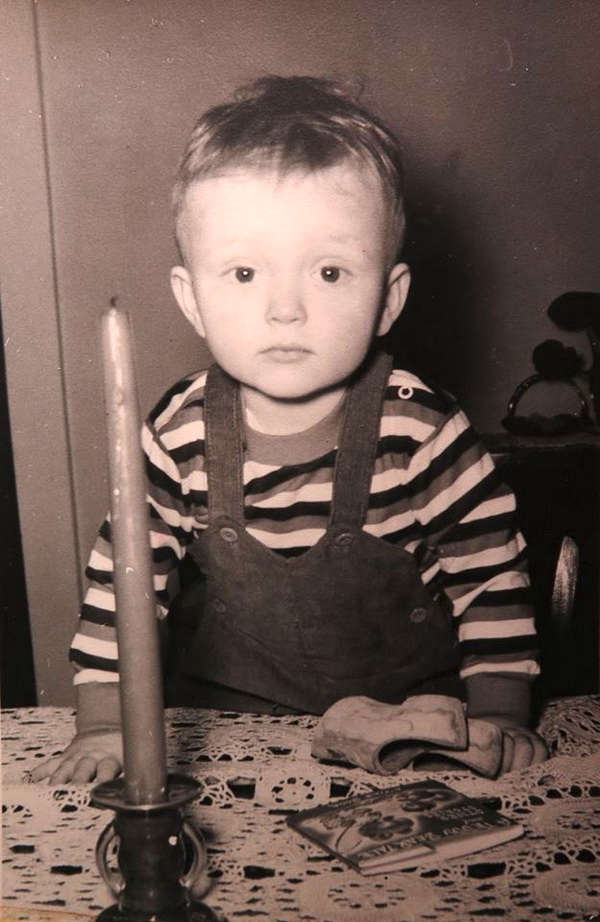
My mother tells me she took this photograph of me in the dining-room mirror. If so, she had skills with a camera that I failed to recognize for decades. It’s a superb image. There is no flash reflection, no reflected image of the taker; the picture is decently-exposed.
What does this image, and my decision to include it, say of me? That even then I had a tendency to introspection, looking into but also past myself? Perhaps. I also find the inclusion of the candle apposite. That is where it often sat; I doubt it was placed there for symbolic effect. But, somehow, it adds a very great deal to the picture in a way I can’t quite explain.
I flinch at most other pictures of me. I was an awkward, ungainly child, ever too-conscious of being seen and imagining the worst of it. As an adult, I developed a squint that looks like a perpetual smirk, as if I am chuckling at some superficial inside joke. I tend to imagine myself visually in the ugliest and most critical of terms. But here, before this image, I feel empathy. I know you, child. I know how things were for you. I know how things turned out. I wish I could have given you a happier future.
Of all writers, Roland Barthes speaks most fluently of looking back on the child, not without pain, but nonetheless with some sort of . . . I don’t know—absolution isn’t quite the right word, but it comes close:
“What right does my present have to speak of my past? Has my present some advantage over my past? What ‘grace’ might have enlightened me?—except that of passing time, or of a good cause, encountered on my way? …
From the past, it is my childhood which fascinates me most; these images alone, upon inspection, fail to make me regret the time which has vanished. For it is not the irreversible I discover in my childhood, it is the irreducible: everything which is still in me, by fits and starts; in the child, I read quite openly the dark underside of myself—boredom, vulnerability, disposition to despairs (in the plural, fortunately), inward excitement, cut off (unfortunately) from all expression.”
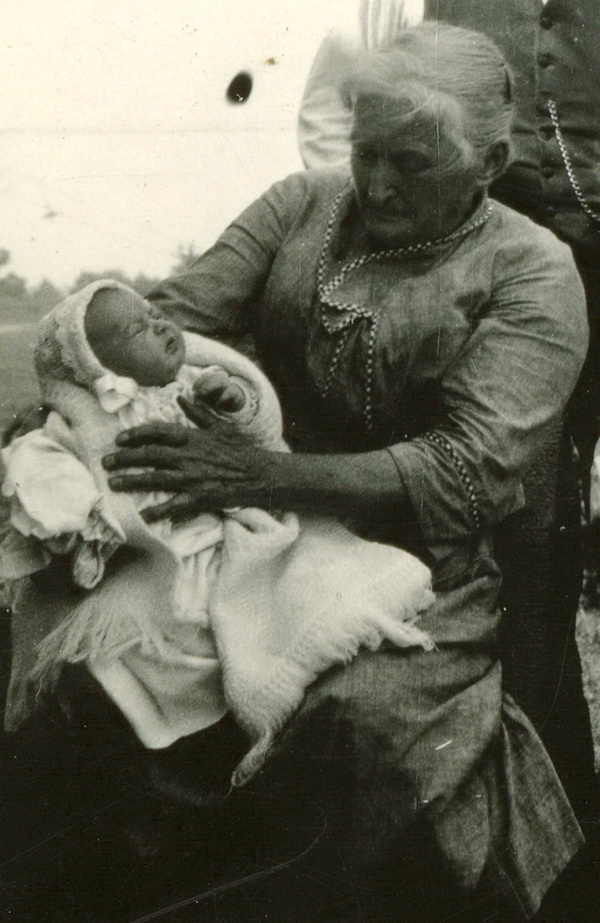
The year is 1923. This is her first grand-daughter, and her namesake. I am drawn to her hands. What a lifetime of scrubbing and wringing and ear-boxing and kneading and cooking and sewing and lifting and holding is folded into them! The darkened skin is partly a trick of the light. But a fortuitous one.
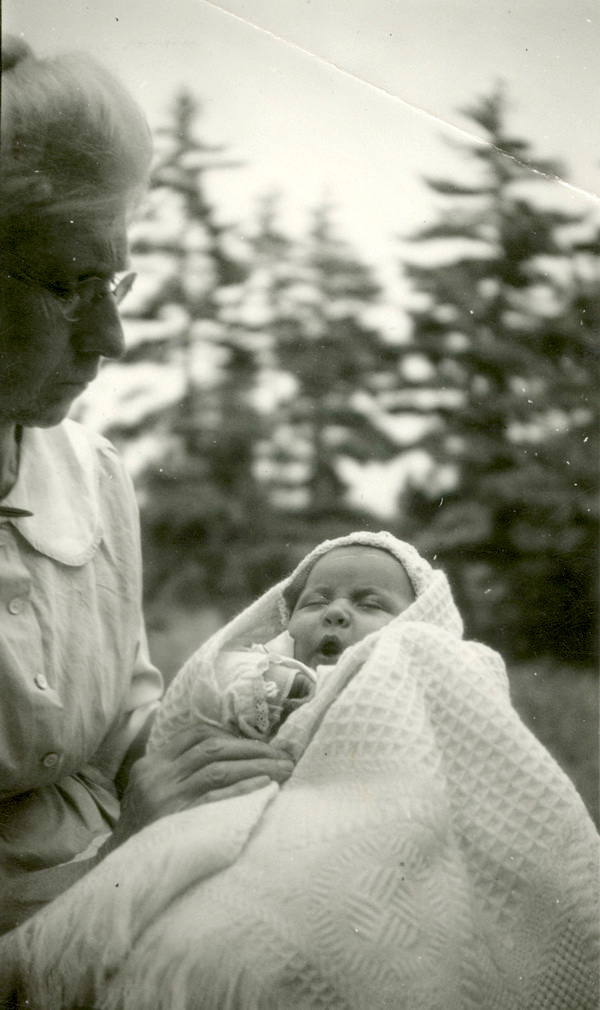
The same child, same year, here held by her other grandmother. A grandmother described to me by one grandchild as formal and austere; watchful of proprieties, bending from a great height to land a dry peck on the cheek. Here, however, she bends close. Her face is intent but expressionless. Or is it?
I admit that I cropped both snapshots for dramatic effect.
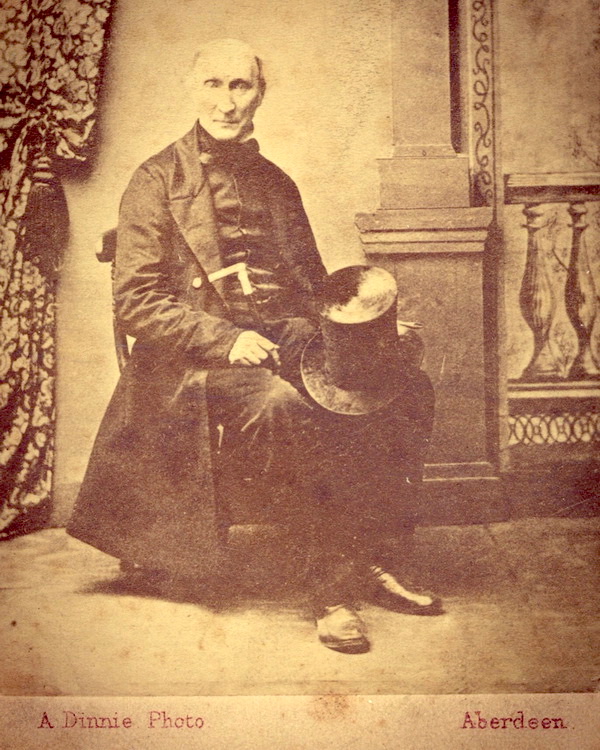
Why does this image fairly shout “Dickens!”?
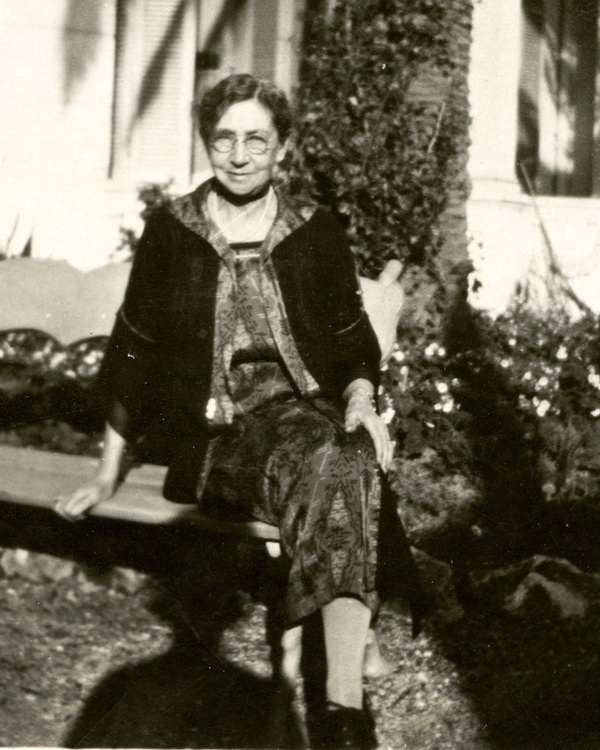
“They had 21 children. They died like flies.”
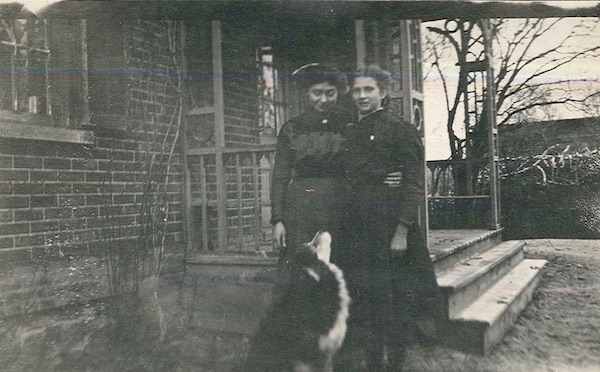
I’ve left all the artifacts in and on view here: the spectral fingers, smudged fingerprints and crooked alignment from the amateur use of home developing equipment a century ago. Plus the banding added by the dying scanner I used to digitize this image last year.
But I confess I was tempted to crop and remove them all in order to focus your eye on the pathos of the scene. Two young women on the cusp of adulthood, in about 1912, one sliding a protective and affectionate hand around the waist of the other but directing her gaze downward to meet the eyes of the dog; the perfect white curve of the dog’s neck as it lifts its face toward her attention.
The girl on the left is Annie, and she lived well into her 90s.
The one on the right with the shy, almost ethereally-reserved half-smile is Florence. Florence died at 16. And no one is now alive who holds in their heart a personal memory of her, or of the ache of her loss.
![]()
Beloved Ones: The Animal & Anthropomorphic

Transportation, transfiguration: This is Jack Dog (who, I was assured, “was a girl”) as horse, with her passenger. Was she told to sit up and present her paws? Or to pull?
Whatever the case, she gestures to us still from the far winter of 1925, from between the ranks of fruit trees long since bulldozed, here stretching back to the woodlot marking the far end of this domesticated space.
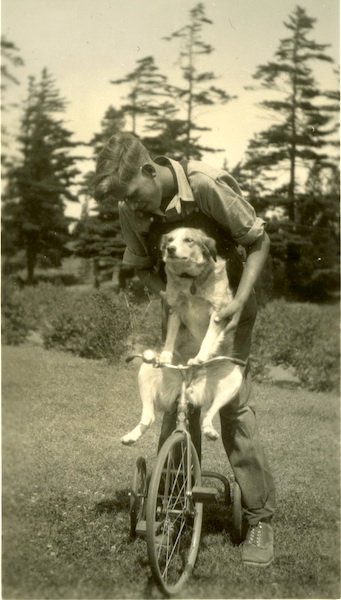
Jack Dog again, in the hands of one John Brown. Again, here, we are in the realm of what passed as cute in the arrangements of humans and animals. But one look at her face tells us differently: fear, confusion, obedience, passivity, a will nonetheless to please. And John Brown? He thought to do no harm. This was a thing humans did to their fellow animals: pose them as if doing human things; dress them in skirts or long johns; train them to hold pipes in their mouths, to shake-um a paw. I read into that compulsion a kind of longing to bridge the human-animal divide.
Jack Dog loved her humans, and they loved her back, sometimes with thoughtless and passing cruelties.
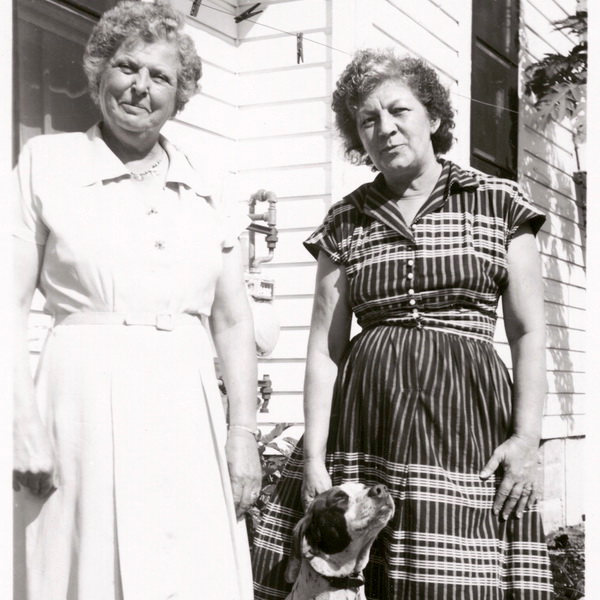
I doubt that the dog or the two women were deliberately posed. This sort of fortuitous moment defines the culture of the snapshot. All three are caught up in sheer, transcendent enjoyment. The two women forget themselves; the dog basks in a present for which forgetting has no register. The similitude in facial expression is an irresistible anthropomorphic conceit on the part of the viewer. And yet, who can gainsay that, in a flash, these three were truly one before the moment passed?
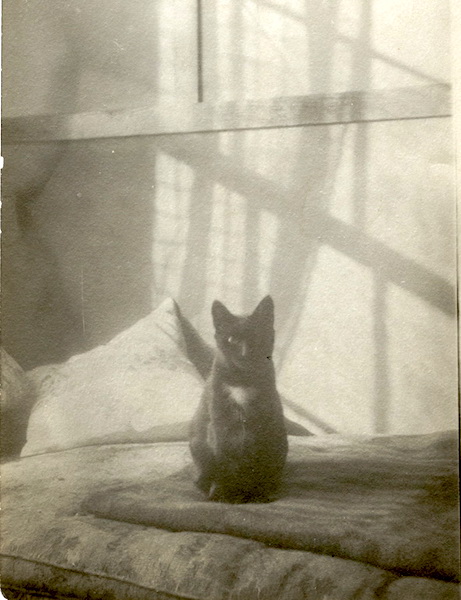
The sun imprints the window opposite on the wall behind, and casts the cat in half-shadow like a phase of the moon. No one knows its name. My mother, the only one who might still remember, is past telling. But someone, eight decades ago, thought to take its picture, alert as if guarding the realm of shadowplay and pattern behind.
![]()
Longing: Water & Fire

“Blue is the color of longing for the distances you never arrive in . . . in this world we actually live in, distance ceases to be distance and to be blue when we arrive in it.”—Rebecca Solnit
On the 13th of May, 1814, a squadron of 750 United States Army troops and Pennsylvania militia under the command of Lieutenant-Colonel John B. Campbell set out from Presque Isle aboard a US Navy flotilla, and crossed Lake Erie, landing the afternoon of the next day at the mouth of a small stream on the north shore of Long Point Bay, south-west of what was then the village of Dover Mills. Their landing-place was a few hundred feet from the forested boundary of the farm on which I would spend my childhood, a century and a half later. The stream that gave on to the lake there ran through and divided our farm—my great-grandfather tiled one branch of it into submission—and I have walked its length. Its centuries of patient gully-formation define space which still, on the eve of its final disappearance under development, furnishes the geography of my dreams.
There was a small skirmish that evening between the raiders and a few local defenders, who then withdrew inland. The next day, 15 May, Campbell’s squadron burned the village and its mills to the ground, sparing the now-homeless women and children their lives but slaughtering all the livestock they found, leaving them dismembered in the street. It was later said that the subsequent British torching of Washington, including the yet-unfinished White House, was in part retaliation for this act.
Campbell was excoriated by both his subordinates and his superiors for his conduct of the raid. But a century later, modern warfare would take similar raids on indigenous villages as a template for a new military objective: the functional destruction of an enemy society to eliminate its capacity to assert itself in war. Campbell landed too soon, and targeted people and things still regarded as sacrosanct.
The image above, taken 201 years later, shows the approximate location of that fateful landing; the sandbar blocks the stream at low water.
What blue led Campbell across that inland sea? What did he long for so strongly that he would darken the blue of a May sky with the smoke of a burning settlement? What love sails before the wind intent on a horizon of destruction?
![]()
References
Image 1. “Tableau vivant, about 1912”
- This is a family photo, but obviously composed with rather more than the usual care, and printed on a postcard (though like many such prints it was never mailed). It features a Kodak box Brownie pointed back at the Brownie-holder who is taking the shot. And a safety bicycle, unsafely half-straddled. At center are the eldest daughter and the Matriarch, watchful and not quite cracking a smile. The women are swaddled in yards of Edwardian fabric. Note the wire fencing; you can still buy that stuff today. In the background, the summer kitchen of a typical Ontario saltbox frame farmhouse of roughly 1840s vintage.
“April is the cruelest month . . .”
- T. S. Eliot, The Waste Land, I. The Burial of the Dead. Boni and Liveright, 1922, online at Poetry Foundation: https://www.poetryfoundation.org/poems/47311/the-waste-land
“They have no life, no animation, no desire, no consideration save in and for the possession of ‘Hard Cash.’”
- William Pope, quoted in Harry B. Barrett, The 19th-Century Journals and Paintings of William Pope. Toronto: M. F. Fehely Publishers Ltd., 1976, p. 87
“This sort of cover-up, if we can call it that, dresses old wounds, physical and psychic, that settlers inflicted on themselves and on the land in the process of ‘taming’ a wilderness.”
- I have written about this in three earlier Weekly Hubris columns: see “An Ocean of Grass, A World of Song,” June 22, 2014; “Reason’s Ghosts: The Settling & Unsettling of the Plains,” August 21, 2014, and “Forgotten Commonwealths: Agrarian Legacies & Lessons,” October 19, 2014.
“Et In Arcadia Ego.”
- Title of three 17th-century Baroque paintings of pastoral scenes. One, by Giovanni Francesco Barbieri (Guercino) is at the Galleria Nazionale d’Arte Antica in Rome. Two subsequent and more famous studies (one held at Chatsworth House and one at the Louvre) are by Nicolas Poussin. Both refer to passages in Virgil’s Eclogues (V, VII and X), and the earlier Idylls of Theocritus that transposed idealized rural Sicilians to the Greek Arcadia. In paintings of this genre, shepherds or other classically-robed rustics encounter and contemplate symbols of death (a skull, a tomb, etc.) in pastoral settings. See “Et In Arcadia Ego,” Wikipedia.
“. . . a last stand of a population of giants (some reached 220 feet with 7-foot boles) that once covered much of Ontario . . .”
- “I found a description in the Canadian archives of a white pine that was cut from southern Ontario, a portion of which was displayed at the international exhibit of London in 1862. It was over 200 cm (7 feet) in diameter, 67 metres (20 stories) tall, and the first branch was more than 10 stories above the ground—higher than the tops of most pine trees today. The tallest white pine in Ontario today is only 47 metres tall, a little over two thirds the height of this historic tree. The 1862 pine contained enough wood to build six modern three-bedroom bungalows. Near the shores of Lake Erie the larger pines were reported to often reach 60 metres in height and over 150 cm (5 feet) in diameter.” Michael Henry, “The past isn’t what it used to be,” Ancient Forest Exploration & Research, July 16, 2015.
“Sand has now become a scarce resource . . .”
- Josh Gabbatiss, “Sand mafias and vanishing islands: How the world is dealing with the global sand shortage,” The Independent, December 6, 2017.
- See also Aurora Torres, Jodi Brandt, Kristen Lear, Jianguo Liu et al., “A looming tragedy of the sand commons,” Science 357(6355), 8 September, 2017, pp. 970-971.
“Trees sense threat collectively; they co-operate with other organisms in rooted biological communities, they do not just compete for canopy space but give way to each other.”
- Richard Schiffman, “Are Trees Sentient Beings? Certainly, Says German Forester,” YaleEnvironment360, Yale School of Forestry & Environmental Studies, November 16, 2016.
- Kent McFarland, “Eastern White Pine: A Meat-Eater?” Adirondack Almanack, August 27, 2013.
- “Canopy shyness,” Venerable Trees, n.d.
“. . . known between 1915 and 1925 as the most popular humorist in the English-speaking world.”
- See “Stephen Leacock,” Wikipedia.
“. . . the sorrowful little boy serves the iconography of the cute . . .”
- Sianne Ngai, Our Aesthetic Categories: Zany, Cute, Interesting. Harvard University Press, 2015.
“Of all writers, Roland Barthes speaks most eloquently of looking back on the child . . .”
- Roland Barthes, by Roland Barthes (Hill & Wang, 1977)
“Blue is the colour of longing for the distances you never arrive in . . .”
- Rebecca Solnit, A Field Guide to Getting Lost (Penguin, 2006)
“The next day, 15 May, Campbell’s squadron burned the village and its mills . . .”
- See “Raid on Port Dover,” Wikipedia.
![]()
Image Credits
Image 1. Author collection.
Image 2. Homer Rainsford Watson, “Near the Close of a Stormy Day” (1884), Winnipeg Art Gallery. Public domain. From Wikimedia Commons, https://commons.wikimedia.org/wiki/File:Homer_Ransford_Watson_-_Near_the_Close_of_a_Stormy_Day_(1884).jpg
Image 3. Author photo.
Image 4. Library and Archives Canada, Acc. No. 1955-129-2. Copyright expired. See under “Record Information—Details,” at http://www.bac-lac.gc.ca/eng/CollectionSearch/Pages/record.aspx?app=FonAndCol&IdNumber=2833188, and http://www.bac-lac.gc.ca/eng/Pages/terms-and-conditions.aspx#copyright.
Image 5. Author collection.
Image 6. Family collection, scan courtesy of B. Rawlings.
Images 7 and 8. Author collection.
Images 9 and 10. Family collection, scans courtesy of B. Rawlings.
Image 11. Author collection.
Image 12. Family collection; negative scan courtesy of B. Rawlings.
Images 13—15. Author collection
Image 16. Family collection; negative scan courtesy of B. Rawlings.
Image 17. Author collection.
Image 18. Author photo.
